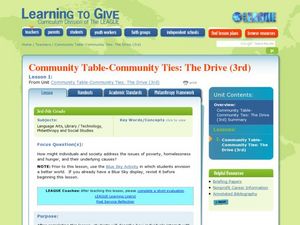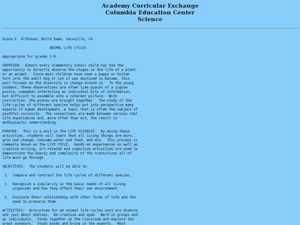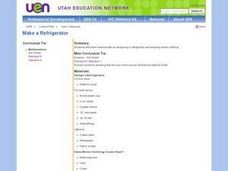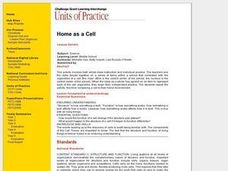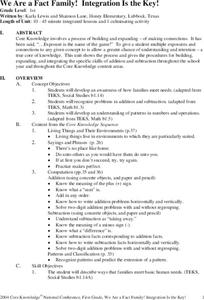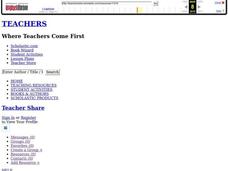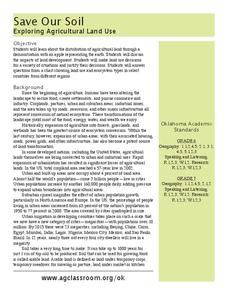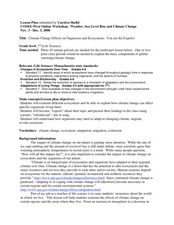Curated OER
Animal and Plant Habitats
Second graders write and illustrate a story. In this habitats lesson plan, 2nd graders learn about different types of plant and animal habitats. Students view video segments about habitats, answer comprehension questions, complete a...
Curated OER
Community Table-Community Ties: The Drive
Students explore the concept of philanthropy. In this service learning lesson, students consider the issues of hunger and homelessness. Students explore literature dealing with the topics and brainstorm ways they may be able to help others.
Curated OER
Vermicomposting
First graders investigate composting. In this biology lesson plan, 1st graders identify ways to use garbage as fertilizer. Students examine soil and compost matter as well as the role of worms in the dirt.
Curated OER
Earth Book
After viewing a teacher-led demonstration on a variety of landforms of the Earth, 1st graders create an Earth book. This nicely-done hands-on lesson has students produce books that describe, in pictures and words, different aspects of...
Curated OER
Families
First graders complete a unit on families and family structures. They create a family tree for their own family, construct a family mobile, sort and discuss photos of families from around the world, create a banner of ways to say "I...
Curated OER
Classification of Cerealites
Students create a dichotomous key. In this categorizing lesson, students create a dichotomous key for different types of cereal. Students classify the cereal into groups such as flakes and cereal with holes. Students discuss their...
Curated OER
Cold and Warm Blooded Animals
Students research facts about a cold or warm-blooded animal in order to designa report either as PowerPoint or word processed document. They use online resources and insert images in to the report. They include the specified criteria and...
Curated OER
Animal Life Cycle
Students conduct hands-on experiments. In this life cycle instructional activity, students are able to observe a variety of animals as they travel through their life cycle (brine shrimp, mealworms, frog eggs and chicken eggs). Students...
Curated OER
What's Wild?
Third graders define domesticated animal and wildlife. In this animal lesson plan, 3rd graders cut pictures out of magazines of both types of animals and make two collages with the pictures.
Curated OER
Shedding Light on Watersheds
Students discuss what a watershed is, complete online activities showing them how to take care of a watershed, and create a model of a watershed that they experiment with to see what happens when it is disrupted by civilization.
Curated OER
Make a Refrigerator
Third graders explore the concept of heat transfer as experienced in wearing winter clothing and analyzing the refrigerator.
Curated OER
Home as a Cell
Middle schoolers correlate a series of items with the organelles of a cell. They compare the school to a cell, and create a drawing that compares the cell structure with their home.
Curated OER
Ocean Life
Students explore the topics of ocean water salinity, ocean life zones, marine life classification, and ocean food chains. They observe demonstrations, conduct experiments, complete quizzes and handouts, and analyze key vocabulary.
Curated OER
Characteristics of Snakes and Turtles
Students examine the characteristics of snakes and turtles and compare/contrast reptiles with mammals. They watch a video, answer discussion questions, complete information charts, conduct Internet research, and create a habitat diorama.
Curated OER
Would You Like A Desert With That?
Students explore the four different deserts in the United States and their characteristics. They discuss the four different types of deserts in United States and their characteristics, and locate them on a map.
Curated OER
Biology: Cells and Chemical Changes
Students explore the numerous functions of cells in both plants and animals. Following a pre-assessment, they construct cell models and examine onion cell slides stained with iodine or dye. After participating in experiments on how to...
Curated OER
Discovering Seeds
Students compare seeds with seedlings. In this life science lesson plan, students make observations of seedlings and the seeds they grew from, paying special attention to the roots. Lesson includes extension activities.
Curated OER
We Are a Fact Family! Integration Is the Key!
Students practice addition and subtraction. In this fact families unit, students practice finding sums and differences for fact families. This unit includes ten lessons with science and social studies integration.
Curated OER
Starfish
Learners explore the concept of starfish. In this starfish lesson, students identify the parts of a starfish and how their body works. Learners create a starfish using paint and a cornmeal mixture. They then glue on Cheerios to...
Curated OER
Amphibians Internet Activity
In this amphibians worksheet, students click on the links in the questions about amphibians to find the answers to the questions and then come back and answer the questions. Students answer 10 questions total.
Curated OER
How Long Until Dirt
Third graders examine the difference between composting and wasting food. They problem-solve what to do about leftovers after lunches so good food doesn't go to waste.They study food storage techniques that are environmentally friendly...
Curated OER
Water Topics
In this science learning exercise, students focus on the role of water in the environment and its many uses. They answer questions in the multiple choice and short answer form.
Curated OER
Save Our Soil
Students read about the history of soil and complete language arts, math, social studies, and more activities about soil. In this soil lesson plan, students complete fraction problems, create a school compost pile, write about conserving...
Curated OER
Climate Change Effects on Organisms and Ecosystems: You are the Experts!
Seventh graders research about the effect of climate on different ecosystems. In this life science lesson, 7th graders present their research by creating a poster, infomercial, skit or song. They discuss how organisms adapt to climate...



